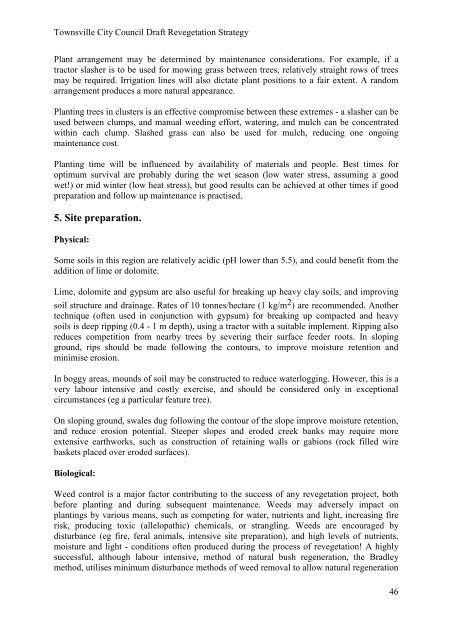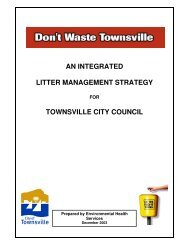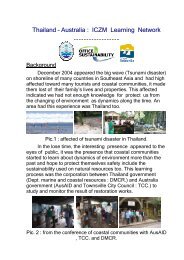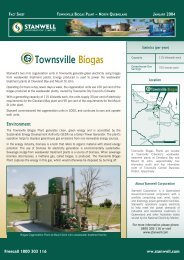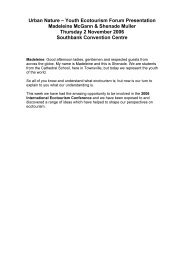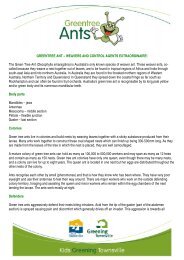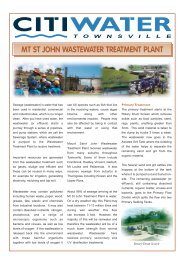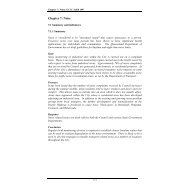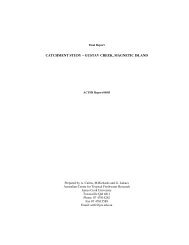Revegetation Strategy - Townsville State of the Environment Report
Revegetation Strategy - Townsville State of the Environment Report
Revegetation Strategy - Townsville State of the Environment Report
Create successful ePaper yourself
Turn your PDF publications into a flip-book with our unique Google optimized e-Paper software.
<strong>Townsville</strong> City Council Draft <strong>Revegetation</strong> <strong>Strategy</strong><br />
Plant arrangement may be determined by maintenance considerations. For example, if a<br />
tractor slasher is to be used for mowing grass between trees, relatively straight rows <strong>of</strong> trees<br />
may be required. Irrigation lines will also dictate plant positions to a fair extent. A random<br />
arrangement produces a more natural appearance.<br />
Planting trees in clusters is an effective compromise between <strong>the</strong>se extremes - a slasher can be<br />
used between clumps, and manual weeding effort, watering, and mulch can be concentrated<br />
within each clump. Slashed grass can also be used for mulch, reducing one ongoing<br />
maintenance cost.<br />
Planting time will be influenced by availability <strong>of</strong> materials and people. Best times for<br />
optimum survival are probably during <strong>the</strong> wet season (low water stress, assuming a good<br />
wet!) or mid winter (low heat stress), but good results can be achieved at o<strong>the</strong>r times if good<br />
preparation and follow up maintenance is practised.<br />
5. Site preparation.<br />
Physical:<br />
Some soils in this region are relatively acidic (pH lower than 5.5), and could benefit from <strong>the</strong><br />
addition <strong>of</strong> lime or dolomite.<br />
Lime, dolomite and gypsum are also useful for breaking up heavy clay soils, and improving<br />
soil structure and drainage. Rates <strong>of</strong> 10 tonnes/hectare (1 kg/m 2 ) are recommended. Ano<strong>the</strong>r<br />
technique (<strong>of</strong>ten used in conjunction with gypsum) for breaking up compacted and heavy<br />
soils is deep ripping (0.4 - 1 m depth), using a tractor with a suitable implement. Ripping also<br />
reduces competition from nearby trees by severing <strong>the</strong>ir surface feeder roots. In sloping<br />
ground, rips should be made following <strong>the</strong> contours, to improve moisture retention and<br />
minimise erosion.<br />
In boggy areas, mounds <strong>of</strong> soil may be constructed to reduce waterlogging. However, this is a<br />
very labour intensive and costly exercise, and should be considered only in exceptional<br />
circumstances (eg a particular feature tree).<br />
On sloping ground, swales dug following <strong>the</strong> contour <strong>of</strong> <strong>the</strong> slope improve moisture retention,<br />
and reduce erosion potential. Steeper slopes and eroded creek banks may require more<br />
extensive earthworks, such as construction <strong>of</strong> retaining walls or gabions (rock filled wire<br />
baskets placed over eroded surfaces).<br />
Biological:<br />
Weed control is a major factor contributing to <strong>the</strong> success <strong>of</strong> any revegetation project, both<br />
before planting and during subsequent maintenance. Weeds may adversely impact on<br />
plantings by various means, such as competing for water, nutrients and light, increasing fire<br />
risk, producing toxic (allelopathic) chemicals, or strangling. Weeds are encouraged by<br />
disturbance (eg fire, feral animals, intensive site preparation), and high levels <strong>of</strong> nutrients,<br />
moisture and light - conditions <strong>of</strong>ten produced during <strong>the</strong> process <strong>of</strong> revegetation! A highly<br />
successful, although labour intensive, method <strong>of</strong> natural bush regeneration, <strong>the</strong> Bradley<br />
method, utilises minimum disturbance methods <strong>of</strong> weed removal to allow natural regeneration<br />
46


